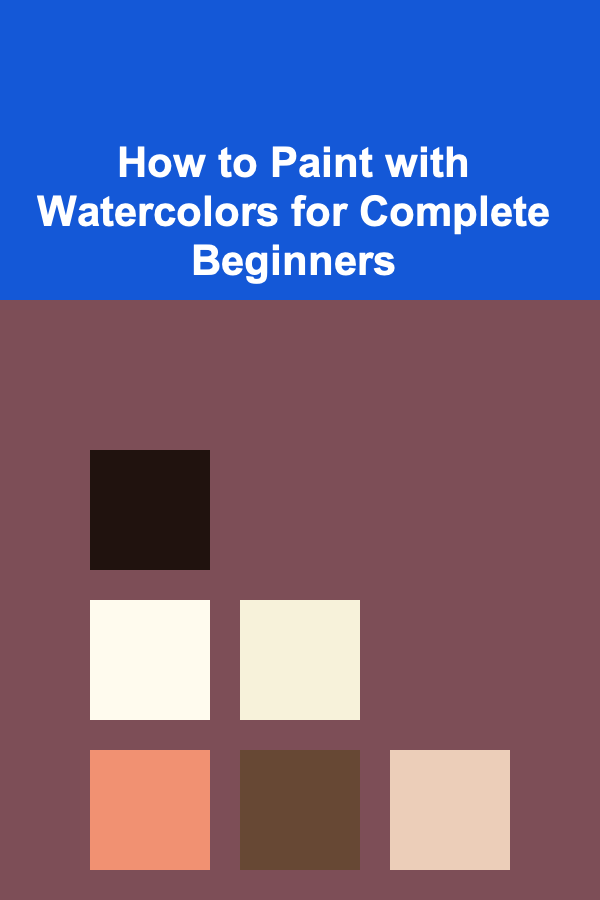
How to Paint with Watercolors for Complete Beginners
ebook include PDF & Audio bundle (Micro Guide)
$12.99$5.99
Limited Time Offer! Order within the next:

Watercolor painting is a beautiful and versatile art form that has captured the hearts of artists for centuries. The fluidity, transparency, and ethereal qualities of watercolor make it an exciting medium to work with. However, as a beginner, it can also be intimidating due to its unpredictable nature. But fear not! With patience, practice, and the right approach, anyone can learn to paint with watercolors. In this guide, we will walk you through everything you need to know to get started with watercolor painting as a complete beginner.
Understanding Watercolor Paints and Supplies
Before you dive into your first painting, it's essential to understand the basic supplies and how they work. The world of watercolor painting has a wide range of materials, but starting simple is key.
Watercolor Paints
Watercolors come in two main forms: tubes and pans. Both are suitable for beginners, but they have different characteristics:
- Watercolor Tubes: These offer a more vibrant and intense pigment. They are ideal for mixing large amounts of color or creating more fluid washes.
- Watercolor Pans: These are compact and more portable. They are great for small studies or when you need to work on the go.
For beginners, watercolor pans are often recommended because they are convenient, less messy, and perfect for experimenting. As you become more advanced, you may choose to use tube watercolors for larger or more detailed works.
Brushes
Choosing the right brushes can make a significant difference in your painting experience. Watercolor brushes come in various shapes and sizes. Here are some common ones for beginners:
- Round Brushes: These are versatile brushes that can create fine lines or broad washes. They are perfect for detail work and filling in areas.
- Flat Brushes: These are great for making broad strokes or for filling in larger areas.
- Filbert Brushes: These brushes combine the characteristics of round and flat brushes and can be used for both detailed and broad strokes.
Paper
Watercolor paper is specially designed to handle the amount of water you'll be using. You can't use just any type of paper, as it will not absorb water properly, and the paint may bleed or warp.
- Cold Press (Not) Paper: This paper has a slightly textured surface and is often favored by beginners. It holds water well and gives a soft, smooth finish.
- Hot Press Paper: This is a smooth paper that is great for detailed work, but it doesn't absorb water as well as cold press.
- Rough Paper: As the name suggests, rough watercolor paper has a very textured surface. This can create more dramatic effects but is often more difficult for beginners to control.
Additional Supplies
- Water Containers: You'll need at least two containers -- one for rinsing your brushes and the other for clean water to mix with your paint.
- Paper Towels or Sponges: These are essential for blotting or soaking up excess water from your painting.
- Palette: A palette is where you'll mix your paints. You can use a traditional porcelain palette or a plastic one, depending on what you prefer.
Basic Watercolor Techniques for Beginners
Once you have your supplies ready, it's time to learn some basic watercolor techniques. These will form the foundation for all your watercolor paintings.
1. Wet-on-Wet Technique
This technique involves applying wet paint onto wet paper. When you apply paint to a damp surface, the colors will spread and bleed in beautiful, unpredictable ways. Wet-on-wet is great for creating soft gradients or backgrounds, as well as atmospheric effects like skies or fog.
How to Do It:
- Wet the area of the paper where you want to paint using a clean brush or spray bottle.
- Apply watercolor paint directly onto the wet surface.
- Watch as the paint spreads and blends, creating a smooth, diffused effect.
2. Wet-on-Dry Technique
The wet-on-dry technique involves applying wet paint onto dry paper. This technique is ideal for creating sharp, defined lines, and is often used for painting details and textures. This method gives more control over the paint's behavior and allows you to layer different colors.
How to Do It:
- Let the paper dry completely before applying any paint.
- Dip your brush into the water and mix your watercolor paint.
- Paint directly onto the dry paper, making sure the color stays where you want it.
3. Graded Wash (Ombre)
A graded wash is a gradual transition from light to dark, or from one color to another. This technique is great for painting skies, seas, or any area where you want a smooth transition of color.
How to Do It:
- Wet the paper with clean water.
- Start painting from one edge of the paper, gradually increasing the concentration of color as you move across the paper.
- You can control the amount of pigment by adjusting how much water you mix with the paint.
4. Dry Brush Technique
The dry brush technique is used to create rough, textured effects. It's often used for painting details like tree bark, grass, or any area where you want to add texture.
How to Do It:
- Dry off your brush with a paper towel so that it's not soaked with water.
- Dip the brush into the watercolor paint, ensuring it's not too wet.
- Lightly drag the brush across the dry paper. This will create rough, irregular strokes and textures.
5. Lifting and Blotting
Lifting involves removing some of the paint from the paper, which can create highlights or add texture. This can be done with a sponge, paper towel, or a clean, damp brush. Blotting is a similar technique but uses a towel to remove excess paint or water.
How to Do It:
- After applying a wash, use a damp brush or sponge to lift off some of the paint.
- Blot the paint with a paper towel to absorb excess water or to create softer edges.
Understanding Color Mixing
Watercolor is all about color mixing. Unlike oil or acrylic paints, watercolors are often used in transparent layers, so how you mix your colors can greatly impact the final result. Let's take a look at the basic principles of mixing watercolors.
The Color Wheel
The color wheel is a fundamental tool for understanding how colors interact. It consists of primary colors (red, yellow, and blue), secondary colors (orange, green, and purple), and tertiary colors (colors created by mixing primary and secondary colors).
By understanding color relationships, you can create harmonious and visually pleasing compositions. Complementary colors (colors opposite each other on the wheel) can create vibrant contrasts, while analogous colors (colors next to each other) create more subtle, harmonious blends.
Mixing Colors
To mix watercolors, you'll need to adjust the amount of water and pigment in your palette. More water results in lighter, more transparent colors, while less water makes the colors more vibrant and opaque.
Start with a basic set of primary colors (red, blue, and yellow) and experiment with mixing them to create secondary colors (orange, green, and purple). This will help you understand how the colors behave when mixed.
Creating a Palette
You don't need to buy every color in the store. Instead, start with a limited palette and learn how to mix your own shades. A basic beginner's palette should include:
- Cadmium Red or Alizarin Crimson (for warm reds)
- Ultramarine Blue or Cobalt Blue (for cool blues)
- Cadmium Yellow or Lemon Yellow (for warm yellows)
- Burnt Umber or Payne's Grey (for earthy tones)
Experiment with creating different hues by mixing these colors and adding water to adjust the intensity.
Step-by-Step Guide to Your First Watercolor Painting
Now that you have the foundational knowledge, it's time to create your first watercolor painting! Follow these simple steps for a beginner-friendly project.
Materials Needed:
- Watercolor paints (pans or tubes)
- Watercolor brushes (round and flat)
- Watercolor paper (preferably cold press)
- Palette
- Water containers
- Paper towels
Steps:
- Choose Your Subject: For your first painting, choose a simple subject like a landscape, fruit, or flowers. Simple shapes and broad areas of color are easier for beginners.
- Sketch Your Subject: Lightly sketch your subject with a pencil. Keep your lines light and simple, as these will be covered by the paint.
- Prepare Your Colors: Squeeze out a small amount of watercolor paint onto your palette. Add a bit of water to activate the paint and create the desired consistency.
- Start with the Background: Begin with the background or larger areas, applying a wet-on-wet or wet-on-dry technique to create smooth washes.
- Layer and Build: Once the first layer is dry, begin layering on more details and colors. Use a wet-on-dry technique to add depth and definition.
- Add Details: Use smaller brushes and more concentrated colors to add details like leaves, stems, or textures.
- Finishing Touches: Once you're satisfied with your painting, let it dry completely. You can add final touches or highlights by lifting paint with a damp brush or sponge.
Troubleshooting Common Problems
As a beginner, you may encounter some challenges while painting. Here are a few common problems and how to address them:
1. Paint Bleeding Out of Control
If your paint spreads too much, it's likely because the paper is too wet or the paint is too diluted. Try using less water and letting the paper dry a little before applying more paint.
2. Colors Looking Muddy
Mixing too many colors together can lead to muddy results. Stick to mixing a few complementary or analogous colors, and always test your mixes on scrap paper first.
3. Uneven Washes
If your wash is uneven, make sure you apply a consistent layer of water across the paper before adding the paint. Keep your brush moving in smooth, fluid strokes.
Conclusion
Watercolor painting is an exciting and rewarding creative outlet, especially for beginners. With the right tools, techniques, and a bit of patience, you can master this beautiful medium and express yourself in new and exciting ways. Remember, it's all about practice and experimentation---so don't be afraid to make mistakes and learn along the way. Happy painting!
Reading More From Our Other Websites
- [Small Business 101] Top E-commerce Platforms for Small Business: Best Choices for 2025
- [Home Party Planning 101] How to Create a Home Party Menu That Will Please Everyone
- [Organization Tip 101] How to Create a Seasonal DIY Project Calendar
- [Home Budget Decorating 101] How to Make a Small Space Look Expensive on a Tight Budget
- [Trail Running Tip 101] Beyond Water: Electrolyte Solutions and Nutrition Hacks for Long-Distance Trail Runs
- [Home Soundproofing 101] How to Minimize Noise from Household Appliances with Soundproofing
- [Tie-Dyeing Tip 101] From White Shirts to Party-Ready Masterpieces: A Step-by-Step Tie-Dye Guide
- [Personal Investment 101] How to Leverage Deep Learning for High-Yield Passive Income Opportunities
- [Star Gazing Tip 101] Top 5 Rooftop and Balcony Hotspots for Nighttime Sky Watching
- [Personal Care Tips 101] How to Pick a Sunscreen with Broad Spectrum Protection

How to Create a Family Game Day with Board Games
Read More
How to Decorate Your Home Office for the Holiday Season
Read More
How to Make Your Home More Accessible During Renovation
Read More
How to Organize Your Home Bar for Stylish Entertaining
Read More
How to Secure Your Home During Renovations or Construction
Read More
How to Style Your Home with DIY Crafts on a Budget
Read MoreOther Products

How to Create a Family Game Day with Board Games
Read More
How to Decorate Your Home Office for the Holiday Season
Read More
How to Make Your Home More Accessible During Renovation
Read More
How to Organize Your Home Bar for Stylish Entertaining
Read More
How to Secure Your Home During Renovations or Construction
Read More